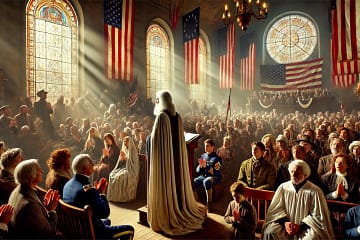“The Pit and the Pendulum,” written by Edgar Allan Poe and first published in 1842, is a harrowing tale set during the Spanish Inquisition. The story delves into the psychological and physical tortures endured by the unnamed narrator, blending Poe’s signature gothic atmosphere with a profound exploration of fear and human endurance.
Comprehensive Plot Summary
Amidst the grim and shadowy proceedings of the Spanish Inquisition, a man finds himself ensnared by forces beyond his control. Condemned to death, he faces a sentence that reverberates through his soul, echoing the finality of his fate. As the dread words are spoken, his senses blur and fade, merging into a surreal haze of indistinct shapes and sounds. When he regains consciousness, he is enveloped in darkness, a darkness so complete that he questions whether he is still among the living.
Disoriented and terrified, the man begins to explore his surroundings with tentative hands. The floor is cold and damp, the air thick with an oppressive weight. He soon discovers the dimensions of his prison—a circular dungeon with smooth, slippery walls. His heart races as he recalls tales of the Inquisition’s torturous methods, whispered in hushed tones and too ghastly to be believed. His fear mounts as he realizes he is at the mercy of these merciless captors.
In his blind groping, the man stumbles upon the edge of a yawning pit in the center of the dungeon. The mere touch of its brink sends a chill down his spine, the abyss symbolizing an end more dreadful than he can fathom. Avoiding a fatal plunge by sheer luck, he collapses, exhausted and overwhelmed. Sleep overtakes him, a restless slumber fraught with nightmares of unseen horrors.
He awakens to find bread and water placed beside him. The realization that his captors aim to prolong his torment rather than grant him the mercy of a swift death dawns upon him with cruel clarity. Bound now to a wooden framework, he gazes upward and notices a pendulum descending from the ceiling. The blade, glinting ominously, swings with a slow and deliberate rhythm, its crescent edge designed to slice through his heart with excruciating precision.
Desperation fuels his thoughts. He devises a plan, using the remnants of his food to lure the dungeon’s rats to his bindings. The rats, driven by hunger, gnaw through the straps, their sharp teeth working feverishly. Just as the pendulum’s blade grazes his chest, he frees himself, narrowly escaping its deadly sweep.
His respite is fleeting. The walls of the dungeon begin to glow and shift, the metallic plates heating and moving inward. The suffocating heat forces him toward the pit’s edge once more. The walls, now burning hot, press him closer and closer to the brink. With no other option, he prepares to leap into the darkness below, choosing this uncertain fate over the agonizing death by fire.
As he teeters on the edge, ready to surrender to the abyss, a cacophony erupts—a clash of voices, the blare of trumpets, and the thunderous sound of crumbling walls. The dungeon’s walls retract, and an outstretched arm catches him just as he begins to fall. It is General Lasalle, leading the French army, who has stormed Toledo and dismantled the Inquisition. The man, saved from the brink of despair, is pulled from the abyss, the nightmare at last giving way to the light of liberation.
With his freedom restored, the man is left to grapple with the trauma of his ordeal. His mind, strained by the terror he has endured, struggles to reconcile the surreal horrors with his newfound reality. Yet, as he emerges from the dungeon into the light of day, there is a glimmer of hope—an unyielding spark of resilience that has survived the darkest depths of human cruelty.
In the grim twilight of the dungeon, he recalls the initial moments of his descent into this hellish ordeal. The first sensation was of falling, a plummet into an abyss so profound that he questioned whether he was alive or dead. He had awoken on a cold stone floor, the air thick with decay and the silence so complete it pressed upon his ears like a physical weight. The memories of his sentencing were fragmented, a blur of robed figures and the murmur of voices condemning him to this pit of despair.
Driven by an instinct for survival, he had begun to explore his prison. The darkness was absolute, robbing him of sight and forcing him to rely on touch. The walls, slick with some unidentifiable moisture, were smooth and unyielding. His groping exploration led him to the edge of the pit, a circular chasm that seemed to breathe with the chill of death. He had recoiled in horror, the realization of his precarious position jolting through him with electric clarity. His initial panic subsided into a grim determination to map his prison, to understand its boundaries and perhaps find some means of escape.
Days passed in a blur of terror and exhaustion. He discovered the bread and water left for him, the cruel generosity of his captors who sought to prolong his suffering. Each morsel of bread was a reminder of their control, each sip of water a bitter acknowledgment of his helplessness. He had resumed his exploration with renewed vigor, counting his steps and marking the turns until he understood the layout of his dungeon. The pit was a constant presence, a yawning mouth ready to swallow him at the slightest misstep.
Bound to the wooden framework, his gaze had been drawn upward to the pendulum. The device was a marvel of infernal ingenuity, its blade designed to descend with torturous slowness. The first sight of it had frozen his blood, but with each swing, a plan had formed in his mind. The rats, initially a source of disgust, became his unwitting allies. He had smeared his bindings with the remains of his meal, praying that their hunger would drive them to gnaw through his bonds. Their sharp teeth and insatiable appetites were his salvation, and as the pendulum’s blade drew nearer, his bindings weakened.
The moment of his escape was a blur of frantic motion. The pendulum grazed his chest, leaving a shallow cut that burned like fire, but he was free. He rolled from the wooden framework, his limbs trembling with the exertion and the fear of his narrow escape. The walls of the dungeon, once a distant threat, now loomed closer, the heat emanating from them driving him toward the pit once more. His choices were stark: death by fire or a plunge into the unknown darkness.
In that final moment of despair, the intervention came. The French army, led by General Lasalle, had breached the stronghold of the Inquisition. The clamor of their assault reached his ears, and he was pulled from the brink of the pit, saved from the ultimate horror. His rescuer’s firm grip was the anchor that drew him back from the edge, the solid reality that shattered the nightmare of his captivity.
Emerging into the light, he felt the weight of his ordeal lift, though the scars it left—both physical and mental—would linger. The dungeon’s darkness had tested his spirit, pushing him to the brink of madness, but he had survived. The resilience that had seen him through the worst of human cruelty now guided him back to life, each step a testament to the endurance of the human soul against unimaginable odds.
Main Characters
- The Narrator: An unnamed protagonist who undergoes extreme psychological and physical torture. His resilience and quick thinking are central to his survival.
- General Lasalle: The leader of the French army who rescues the narrator at the last moment, symbolizing the triumph of enlightenment over the darkness of the Inquisition.
Themes and Motifs
- Fear and Terror: The story explores the depths of human fear, particularly the terror of the unknown and the anticipation of pain.
- Time and Death: The pendulum symbolizes the relentless passage of time leading inexorably to death, heightening the narrator’s psychological torment.
- Human Endurance: Despite facing insurmountable odds and extreme terror, the narrator’s will to survive demonstrates the resilience of the human spirit.
- Oppression and Liberation: The dungeon represents the oppressive power of the Inquisition, while the arrival of General Lasalle signifies liberation and the end of tyranny.
Writing Style and Tone
Poe’s writing style in “The Pit and the Pendulum” is marked by its intense and vivid descriptions that evoke a palpable sense of dread and suspense. His use of first-person narration immerses the reader in the protagonist’s psyche, allowing them to experience his terror firsthand. The narrative is replete with gothic elements, including the macabre setting, the looming threat of death, and the psychological torment of the protagonist.
The tone of the story is dark and foreboding, with an underlying current of despair. Poe masterfully builds tension through detailed and repetitive descriptions of the narrator’s surroundings and his mental state. This meticulous attention to sensory details—such as the feel of the damp dungeon walls, the smell of decayed fungus, and the sound of the pendulum’s swing—creates a claustrophobic atmosphere that enhances the horror of the narrator’s plight.
In conclusion, “The Pit and the Pendulum” is a masterful blend of gothic horror and psychological thriller. Poe’s exploration of fear, time, and endurance not only captivates readers but also provides a profound commentary on the human condition under extreme duress.


